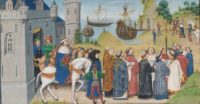Page from an Armenian Manuscript of the Romance of Alexander. Period: Post-Byzantine, 1525 A.D. The museum is open to the public Tuesday through Sunday, 11:30 a.m.–5:30 p.m., except for federal holidays.
Illuminated Manuscript: The Byzantine Emperor Welcoming Roussillon and Martel. Period: Post Byzantine. Written: 1463 – 1465; Illuminated: 1467 – 1472. Artist/Maker: Loyset Liédet (Flemish, active about 1448 – 1478) and Pol Fruit (Flemish, active about 1468).
Museum Description: “Richly dressed in an ermine-collared cloak and magnificent crown, the Byzantine emperor emerges from the city of Constantinople on a white horse, surrounded by members of his court. A religious procession, including a group of clerics singing from open books, precedes him. The emperor appears again in the background at the right, this time greeting the Europeans who disembark from their boat after their long journey. As the rubric just below the miniature explains, in the 800s Girart de Roussillon and Charles Martel went to assist the Emperor of Constantinople in his battles with the Saracens. When Loyset Liédet painted this miniature in the 1400s, the subject had a special resonance: the recent Turkish capture of Constantinople in 1453 recalled the Saracen incursions and prompted calls for European crusaders to rescue the city.”
The J. Paul Getty Museum at the Getty Center in Los Angeles houses European paintings, drawings, sculpture, illuminated manuscripts, decorative arts, and photography from its beginnings to the present, gathered internationally.
Siege of Constantinople in 1453 (fresco), Romanian School, (16th century) – Church of St George, Voronet Monastery, Bukovina, Romania.




